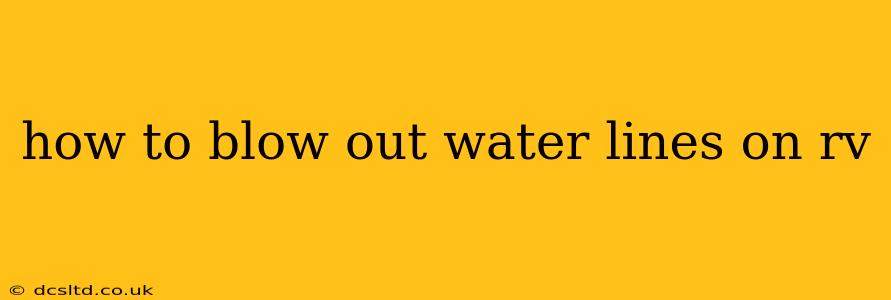Protecting your RV's plumbing system from freezing temperatures is crucial to prevent costly repairs. Blowing out your water lines is a vital step in winterizing your RV, ensuring that no water remains in the pipes to expand and cause damage. This comprehensive guide will walk you through the process step-by-step, answering common questions along the way.
What You'll Need to Blow Out Your RV Water Lines
Before you begin, gather these essential supplies:
- Air compressor: Choose one with at least 100 PSI capacity. A higher PSI is preferable for more efficient blowing. Many RV owners use a portable compressor.
- Air chuck: This is the fitting that connects the air compressor hose to your water system. Ensure it's compatible with your RV's fittings.
- Low-pressure regulator: This is important for precise pressure control and helps prevent damage to your system.
- Extension hoses: You may need these to reach all parts of your plumbing system, especially if you have a larger RV.
- Water pressure gauge (optional but recommended): Monitor your water pressure throughout the process to prevent over-pressurization.
- Safety glasses: Always protect your eyes when working with compressed air.
- Gloves: Protect your hands from potential hazards.
Step-by-Step Guide to Blowing Out Your RV Water Lines
-
Completely drain your RV's water system: This includes emptying your fresh water tank, low-point drains, water heater (if applicable), and all connected hoses and fixtures. Open all faucets and showerheads to ensure complete drainage.
-
Disconnect all hoses: Remove any external hoses connected to your RV, such as those used for city water hookups.
-
Locate your low-point drains: These drains are usually located at the lowest points of your plumbing system and are designed to allow for complete drainage. Open these drains fully.
-
Connect the air compressor: Attach the air chuck to the lowest point of your water system. This is typically the low-point drain. Ensure a tight connection to prevent air leaks.
-
Slowly introduce air: Begin by introducing air into the system slowly. Don't start at maximum pressure immediately. Observe your water pressure gauge if you are using one.
-
Monitor the pressure: Maintain a steady, low pressure while slowly releasing air. Gradually increase the pressure if needed.
-
Check all faucets and fixtures: As you introduce air, check each faucet and showerhead to ensure air is flowing freely. This indicates that the water is being successfully expelled.
-
Repeat for different low-point drains: If your RV has multiple low-point drains, repeat the process for each one to ensure that all parts of the system are thoroughly purged.
-
Sanitize your system (optional): After blowing out your lines, you can sanitize the system by running a mixture of bleach and water through it. Refer to your RV owner's manual for the appropriate ratio and procedure.
-
Add RV antifreeze (if applicable): In very cold climates, consider adding RV antifreeze to the lines as an extra safety precaution, especially for low use RVs. Consult your RV manual for proper antifreeze usage.
Frequently Asked Questions (FAQs)
How much air pressure should I use?
The ideal pressure depends on your RV's system, but typically, 30-60 PSI is sufficient. Start low and gradually increase, always monitoring for leaks or other issues. Never exceed the recommended pressure for your air compressor or RV system.
What happens if I don't blow out my water lines?
If water remains in your RV's water lines during freezing temperatures, the expanding ice can cause pipes to burst, leading to costly repairs and potentially significant water damage.
Can I use a leaf blower to blow out my water lines?
While a leaf blower can generate some air pressure, it is generally not recommended for blowing out RV water lines. Leaf blowers don't usually provide the necessary consistent pressure for effective water removal. They may also not be powerful enough to clear all the water from the lines.
How often should I blow out my water lines?
You should blow out your RV water lines before every anticipated freeze or at the end of each camping season, depending on your climate.
What if I still see water coming out after blowing out the lines?
This could indicate a clogged line, a leak, or that you haven't fully drained the system. Investigate the issue further to pinpoint the problem and take appropriate corrective action.
By following these steps and addressing these common questions, you can effectively blow out your RV's water lines, protecting your investment and ensuring a worry-free winter. Remember to consult your RV's owner's manual for specific recommendations and instructions.
